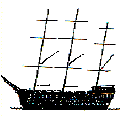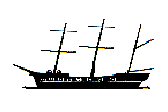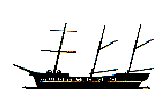Unlike the Man-O-War, the merchant ships (with the exception of the plate fleets) were less heavily armed and often were the property of private or government sanctioned enterprise. Pirates and even privateers, were more inclined to go after weaker vessels such as merchants than to take on warships. The idea was to get rich not get killed. When attacking the pirates would hoist the Jolly Roger to signal the victim to strike or lower their colours. If the merchant's flag did not come down, a red flag which meant "no quarter" would sometimes be raised. This was often a final warning before boarding. If the ship struck her colours upon seeing the red flag, then mercy would still be granted but if the engagement began and the red flag was still flying, the pirates would normally keep their word and slaughter the whole crew, or at least the officers.
Merchant marines were not well paid and like the crews on war ships were sometimes pressed into service. Life on board could be harsh. The crew often had no reason to remain loyal to the officers of the ship or the owners of merchant line. When you combine this poor pay with a lack of military training, most merchants saw no reason to ignore the Jolly Roger or red flag and were more than willing to surrender and let the pirates have the merchandise. In fact on more than one occasion merchant crews mutinied once out to sea and turned pirate due to the poor pay and inadequate leadership.
As mentioned merchant ships were ships that carried cargo. This included slavers (slave ships), spice ships, and general trade ships. The silver and gold laden Spanish fleets were a special type of merchant fleet often referred to as the "plate fleet". Fishing fleets such as whalers and other type work vessels are not normally considered merchant ships but were also known to fall prey to pirates.
As with other sailing ships, a merchant ships type was determined by the number of masts and the way its sails were arranged.
Ship

Ship. Enlarge?
A three masted square rigged ship with a bowsprit
Further more each mast will have the following three parts, the lower mast, top mast and top gallant mast (three yards in which to hang sails.) The bowsprit is the spar jutting from the front of this ship in which sails and is also used to support the mast with stays, or support lines.
Barques (Bark)

Barques. Enlarge?
The Barq is a three masted "brig rigged" ship, that is square rigged on the foremast and mainmast (front two masts)but fore & aft rigged on the mizzenmast with a top sail on the mizzen. Compare to a Barquentine
Barquentine (Barkentine)

Barquentine. Enlarge?
The Barquentine is a three masted ship, square rigged on the foremast but fore & aft rgged on the main and mizzen (back two masts).
Brig

Brig. Enlarge?
A Brig is two masted sailing ship rigged, square on both masts. (so it is similar to ship only it has two masts instead of three or four. Compare to the Brigantine below. In the 1600s a galley like Brig was called a "Cromster"
Brigantine

Brigantine. Enlarge?
The Brigantine is a two masted sailing ship, rigged square on the foremast and fore & aft with square top sails on the mizzenmast.
Schooner

Schooner. Enlarge?
A two masted fore and aft rig sailing vessel. Sometimes a Schooner will have a square rigged top sail on the fore mast After the Sloop, this was probably the most maneuverable of the sailing ships.
If you have three masted ship all rigged fore and aft it is a three masted schooner.
Before everyone screams at me, yes at one time two and three masted for-and-sft rig sailing ships were sloops. However, unless itr was a warship, in the Americas, they were called schooners and the term dates back to the late 1600s. See also Sloop of War.
Merchant Sloop

Sloop. Enlarge?
Sloops are single masted sailing vessels rigged fore and aft with a main sail and a jib. Among all ships, the light and agile sloop was the favorite of the pirates. It's design allowed a pirate to get into trouble as quickly as it got into it. Furthermore the ship, could be operated with a much smaller crew. While it was outgunned by larger sailing ships, it was still a dangerous foe. Pirates rarely won a prize through a battle of attrition. They typically relied on daring surprise and especially bluff. A pirate's ship willingness to fight was usually more than enough for most other ships to surrender. Because of this the sloop with her six or seven guns was often a match for the brigantine with fifteen or twenty guns.
In the event that a larger ship chose to fight, the faster and more maneuverable sloop was often able to out run the larger ship, and more importantly able to maneuver to avoid a broadside.
Two and three masted sloops usually were sloops of war. They were called sloops primarily because they had their guns arranged on a single fighting deck. Merchant Schooners may have also been called sloops but typically by the late 1600s onwards two and three masted fore and aft rigged vessels (other than war ships) were called schooners in the Americas.

The only author and editor of all pages on the site. Most of what I write about is based on years of book reading on the topic. My first web page was published back in 1994.